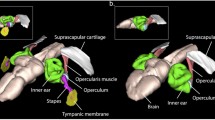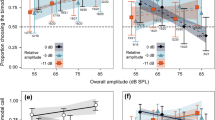Summary
The neotropical frogPhysalaemus pustulosus (Leptodactylidae) has a complex advertisement call and different call components perform different functions. The whine is a necessary and sufficient stimulus for species recognition. The chuck provides information about male body size that is used by females in mate choice (Ryan 1980, 1983), but the chuck must be combined with the species-identifying whine to elicit maximum behavioral responses from males and females. One of the important features of the whine in eliciting behavioral responses from both sexes is the direction of frequency modulation. This suggests that current models of species recognition in anurans based on a frequency filtering mechanism of the peripheral auditory system and selective responses to combinations of frequencies in the central nervous system are not sufficient to explain species recognition inP. pustulosus. Recent neurophysiological studies of the anuran torus semicircularis are discussed in terms of a mechanism for decoding frequency sweeps.
Similar content being viewed by others
References
Barrio A (1965) El géneroPhysalaemus (Anura, Leptodactylidae) en la Argentina. Physis 25:421–448
Bogert CM (1960) The influence of sound on the behavior of amphibians and reptiles. In: Lanyon WE, Tavolga WN (eds) Animal sounds and communication. American Institute of Biologial Sciences, Washington, DC, pp 137–320
Capranica RR (1976) Morphology and physiology of the auditory system. In: Llinás R, Precht W (eds) Frog neurobiology. Springer, Berlin Heidelberg New York, pp 139–165
Capranica RR, Moffat AJM (1980) Nonlinear properties of the peripheral auditory system. In: Popper AN, Lay RR (eds) Proceedings in life sciences, comparative studies of hearing in vertebrates. Springer, Berlin Heidelberg New York, pp 551–575
Drewry GE, Heyer WR, Rand AS (1982) A functional analysis of the complex call of the frogPhysalaemus pustulosus. Copeia 1982:636–645
Frishkopf LS, Capranica RR, Goldstein MH (1968) Neural coding in the bullfrog's auditory system — a teleological approach. Proc Inst Electr Eng [B] 56:969–980
Fuzessery ZM, Feng AS (1982) Frequency selectivity in the anuran auditory midbrain: single unit responses to single and multiple tone stimulation. J Comp Physiol 146:471–484
Gerhardt HC (1974) Mating call differences between eastern and western populations of the treefrogHyla chrysoscelis. Copeia 1974:534–536
Littlejohn MJ, Foquette MJ, Johnson C (1960) Call discrimination by female frogs of theHyla versicolor complex. Copeia 1960:47–49
Loftus Hills JJ (1971) Neural correlates of acoustic behavior in the Australian bullfrogLimnodynastes dorsalis (Anura, Leptodactylidae). Z Vergl Physiol 74:140–152
Martin WF (1972) The evolution of vocalizations in the genusBufo. In: Blair WF (ed) Evolution in the genusBufo. University of Texas Press, Austin, pp 279–309
Mudry KM, Constantine-Paton M, Capranica RR (1977) Auditory sensitivity of the diencephalon of the leopard frogRana p. pipiens. J Comp Physiol 114:1–13
Narins PM (1976) Auditory processing of biologically significant sounds in the treefrog,Eleutherodactylus coqui. Ph D thesis, Cornell University, Ithaca (New York)
Narins PM (in press) Responses of torus semicircularis cells of the coqui treefrog to FM sinusoids. In: Ewert JP (ed) Advances in vertebrate neuroethology. Springer, Berlin Heidelberg New York
Narins PM, Capranica RR (1978) Communicative significance of the two-note call of the treefrogEleutherodactylus coqui. J Comp Physiol 127:1–9
Passmore NI, Caruthers VC 1979 South African frogs. Witwatersrand Press, Johannesburg
Rand AS, Ryan MJ (1981) The adaptive significance of a complex vocal repertoire in a Neotropical frog. Z Tierpsychol 57:209–214
Ryan MJ (1980) Female mate choice in a Neotropical frog. Science 203:523–525
Ryan MJ (1983) Sexual selection and communication in a Neotropical frog,Physalaemus pustulosus. Evolution (in press)
Ryan MJ, Tuttle MD, Rand AS (1982) Bat predation and sexual advertisement in a Neotropical frog. Am Nat 119:136–139
Siegel S 1956 Nonparametric statistics for the behavioral sciences. McGraw Hill, New York
Sokal RR, Rohlf FJ (1969) Biometry, the principles and practice of statistics in biological sciences. Freeman, San Francisco
Straughn IR, Heyer WR (1976) A functional analysis of the mating calls of the Neotropical frog genera of theLeptodactylus complex (Amphibia, Leptodactylidae). Pap Avulsos Zool (São Paulo) 29:221–245
Suga N (1978) Specialization of the auditory system for reception and processing of species-specific sounds. Fed Proc 37:2342–2354
Suga N, Schlegel P (1973) Coding and processing in the auditory systems of FM signal-producing bats. J Acoust Soc Am 54:174–190
Wells KD (1977) The social behaviour of anuran amphibians. Anim Behav 25:666–693
Walkoviak W (1980) The coding of auditory signals in the torus semicircularis of the fire-bellied toad and the grass frog: responses to simple stimuli and to conspecific calls. J Comp Physiol 138:131–148
Author information
Authors and Affiliations
Rights and permissions
About this article
Cite this article
Ryan, M.J. Frequency modulated calls and species recognition in a neotropical frog. J. Comp. Physiol. 150, 217–221 (1983). https://doi.org/10.1007/BF00606371
Accepted:
Issue Date:
DOI: https://doi.org/10.1007/BF00606371




